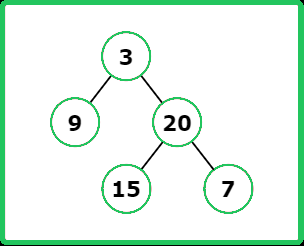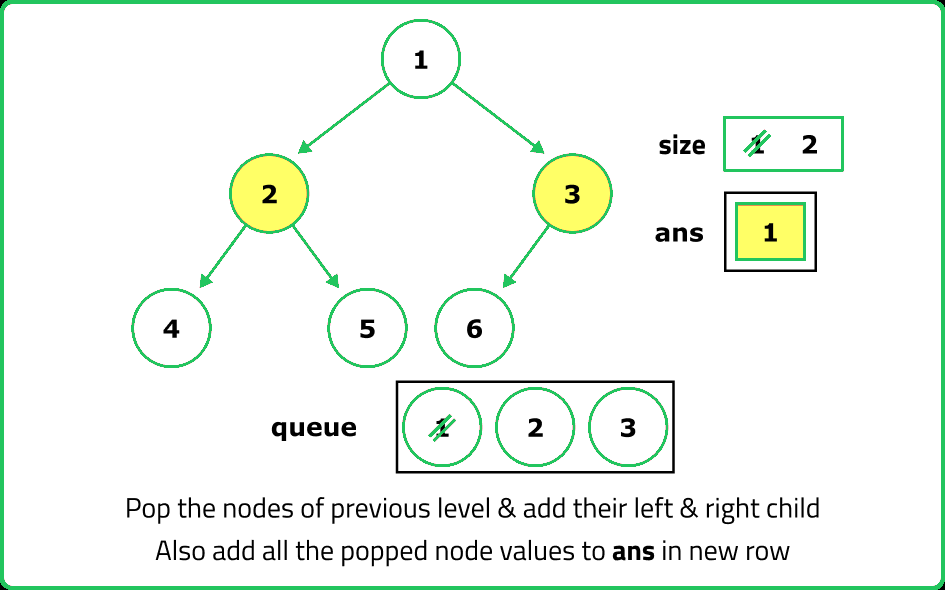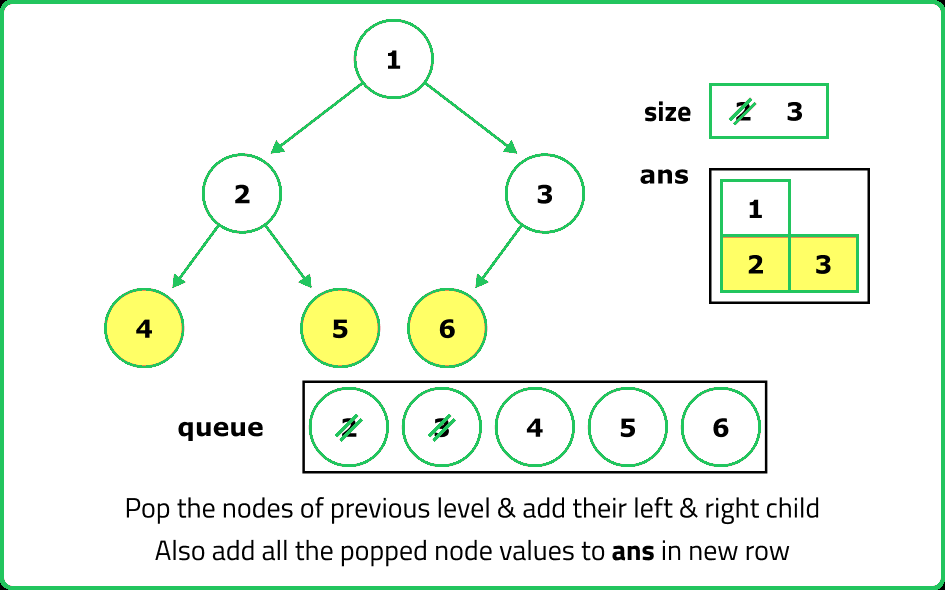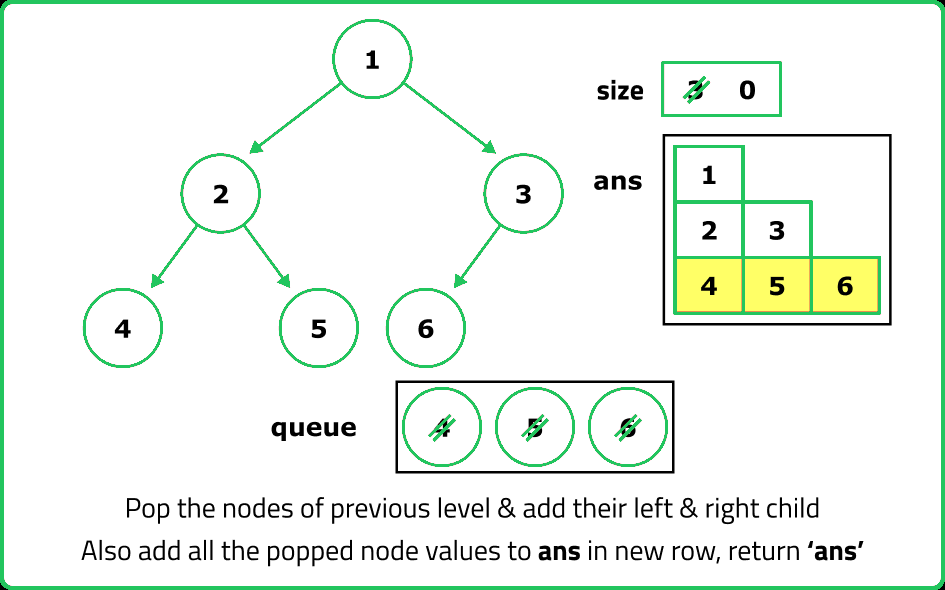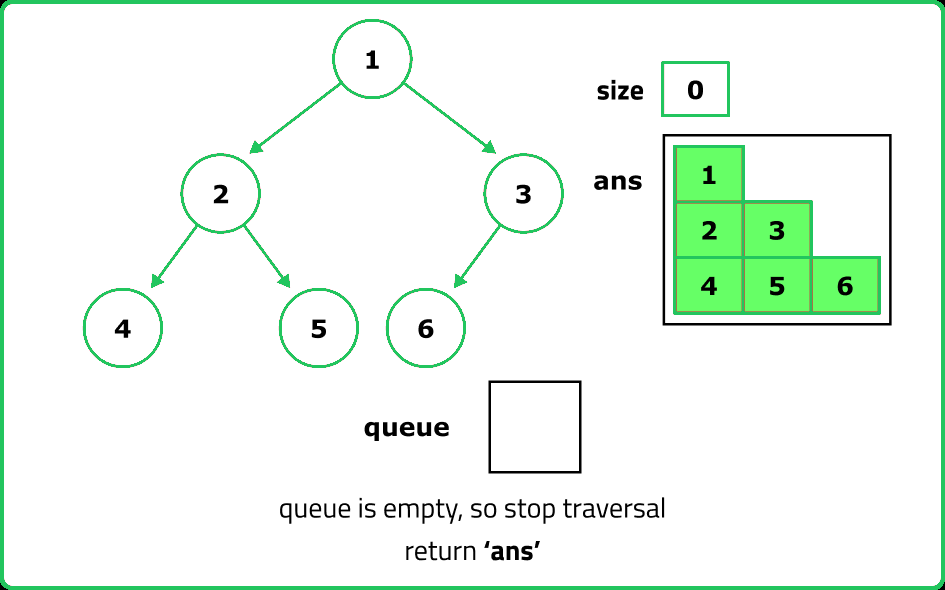1234567891011121314151617181920212223242526272829303132333435363738394041424344454647484950515253545556575859606162636465666768697071727374757677787980818283848586878889909192939495
#include <bits/stdc++.h>
using namespace std;
// Definition for a binary tree node.
struct TreeNode {
int data;
TreeNode* left;
TreeNode* right;
// Constructor with a value parameter for TreeNode
TreeNode(int val) : data(val), left(nullptr), right(nullptr) {}
};
class Solution {
public:
// Function to perform level-order traversal of a binary tree
vector<vector<int>> levelOrder(TreeNode* root) {
// Create a 2D vector to store levels
vector<vector<int>> ans;
if (root == nullptr) {
// If the tree is empty, return an empty vector
return ans;
}
// Create a queue to store nodes for level-order traversal
queue<TreeNode*> q;
// Push the root node to the queue
q.push(root);
while (!q.empty()) {
// Get the size of the current level
int size = q.size();
// Create a vector to store nodes at the current level
vector<int> level;
for (int i = 0; i < size; i++) {
// Get the front node in the queue
TreeNode* node = q.front();
// Remove the front node from the queue
q.pop();
// Store the node value in the current level vector
level.push_back(node->data);
// Enqueue the child nodes if they exist
if (node->left != nullptr) {
q.push(node->left);
}
if (node->right != nullptr) {
q.push(node->right);
}
}
// Store the current level in the answer vector
ans.push_back(level);
}
// Return the level-order traversal of the tree
return ans;
}
};
// Function to print the elements of a vector
void printVector(const vector<int>& vec) {
// Iterate through the vector and print each element
for (int num : vec) {
cout << num << " ";
}
cout << endl;
}
// Main function
int main() {
// Creating a sample binary tree
TreeNode* root = new TreeNode(1);
root->left = new TreeNode(2);
root->right = new TreeNode(3);
root->left->left = new TreeNode(4);
root->left->right = new TreeNode(5);
// Create an instance of the Solution class
Solution solution;
// Perform level-order traversal
vector<vector<int>> result = solution.levelOrder(root);
cout << "Level Order Traversal of Tree: "<< endl;
// Printing the level order traversal result
for (const vector<int>& level : result) {
printVector(level);
}
return 0;
}
1234567891011121314151617181920212223242526272829303132333435363738394041424344454647484950515253545556575859606162636465666768697071727374757677787980818283848586
import java.util.ArrayList;
import java.util.LinkedList;
import java.util.List;
import java.util.Queue;
/**
* Definition for a binary tree node.
* public class TreeNode {
* int data;
* TreeNode left;
* TreeNode right;
* TreeNode(int val) { data = val; left = null; right = null; }
* }
**/
class TreeNode {
int data;
TreeNode left;
TreeNode right;
TreeNode(int val) { data = val; left = null; right = null; }
}
class Solution {
// Function to perform level-order traversal of a binary tree
public List<List<Integer>> levelOrder(TreeNode root) {
// Create a list to store the levels
List<List<Integer>> ans = new ArrayList<>();
if (root == null) {
// If the tree is empty, return an empty list
return ans;
}
// Create a queue to store nodes for level-order traversal
Queue<TreeNode> q = new LinkedList<>();
// Add the root node to the queue
q.add(root);
while (!q.isEmpty()) {
// Get the size of the current level
int size = q.size();
// Create a list to store nodes at the current level
List<Integer> level = new ArrayList<>();
for (int i = 0; i < size; i++) {
// Get the front node from the queue
TreeNode node = q.poll();
// Add the node value to the current level list
level.add(node.data);
// Enqueue the child nodes if they exist
if (node.left != null) {
q.add(node.left);
}
if (node.right != null) {
q.add(node.right);
}
}
// Add the current level to the answer list
ans.add(level);
}
// Return the level-order traversal of the tree
return ans;
}
// Main method to test the level-order traversal
public static void main(String[] args) {
// Creating a sample binary tree
TreeNode root = new TreeNode(1);
root.left = new TreeNode(2);
root.right = new TreeNode(3);
root.left.left = new TreeNode(4);
root.left.right = new TreeNode(5);
// Create an instance of the Solution class
Solution solution = new Solution();
// Perform level-order traversal
List<List<Integer>> result = solution.levelOrder(root);
// Printing the level-order traversal result
System.out.println("Level Order Traversal of Tree:");
for (List<Integer> level : result) {
System.out.println(level);
}
}
}
123456789101112131415161718192021222324252627282930313233343536373839404142434445464748495051525354555657585960616263646566
from collections import deque
# Definition for a binary tree node.
class TreeNode(object):
def __init__(self, val=0, left=None, right=None):
self.data = val
self.left = left
self.right = right
class Solution:
# Function to perform level-order traversal of a binary tree
def levelOrder(self, root):
# Create a list to store levels
ans = []
if not root:
# If the tree is empty, return an empty list
return ans
# Create a queue to store nodes for level-order traversal
q = deque([root])
while q:
# Create a list to store nodes at the current level
level = []
for _ in range(len(q)):
# Get the front node from the queue
node = q.popleft()
# Add the node value to the current level list
level.append(node.data)
# Enqueue the child nodes if they exist
if node.left:
q.append(node.left)
if node.right:
q.append(node.right)
# Add the current level to the answer list
ans.append(level)
# Return the level-order traversal of the tree
return ans
# Function to print the elements of a list
def printList(lst):
# Iterate through the list and print each element
for num in lst:
print(num, end=' ')
print()
# Main function to test the level-order traversal
if __name__ == "__main__":
# Creating a sample binary tree
root = TreeNode(1)
root.left = TreeNode(2)
root.right = TreeNode(3)
root.left.left = TreeNode(4)
root.left.right = TreeNode(5)
# Create an instance of the Solution class
solution = Solution()
# Perform level-order traversal
result = solution.levelOrder(root)
print("Level Order Traversal of Tree:")
# Printing the level order traversal result
for level in result:
printList(level)
123456789101112131415161718192021222324252627282930313233343536373839404142434445464748495051525354555657585960616263646566676869707172737475767778798081828384858687
/**
* Definition for a binary tree node.
* class TreeNode {
* constructor(val = 0, left = null, right = null) {
* this.data = val;
* this.left = left;
* this.right = right;
* }
* }
**/
class TreeNode {
constructor(val = 0, left = null, right = null) {
this.data = val;
this.left = left;
this.right = right;
}
}
class Solution {
// Function to perform level-order traversal of a binary tree
levelOrder(root) {
// Create an array to store levels
const ans = [];
if (!root) {
// If the tree is empty, return an empty array
return ans;
}
// Create a queue to store nodes for level-order traversal
const q = [];
// Add the root node to the queue
q.push(root);
while (q.length > 0) {
// Get the size of the current level
const size = q.length;
// Create an array to store nodes at the current level
const level = [];
for (let i = 0; i < size; i++) {
// Get the front node from the queue
const node = q.shift();
// Add the node value to the current level array
level.push(node.data);
// Enqueue the child nodes if they exist
if (node.left !== null) {
q.push(node.left);
}
if (node.right !== null) {
q.push(node.right);
}
}
// Add the current level to the answer array
ans.push(level);
}
// Return the level-order traversal of the tree
return ans;
}
}
// Function to print the elements of an array
function printArray(arr) {
// Iterate through the array and print each element
console.log(arr.join(' '));
}
// Main function to test the level-order traversal
(function() {
// Creating a sample binary tree
const root = new TreeNode(1);
root.left = new TreeNode(2);
root.right = new TreeNode(3);
root.left.left = new TreeNode(4);
root.left.right = new TreeNode(5);
// Create an instance of the Solution class
const solution = new Solution();
// Perform level-order traversal
const result = solution.levelOrder(root);
console.log("Level Order Traversal of Tree:");
// Printing the level order traversal result
result.forEach(level => printArray(level));
})();
